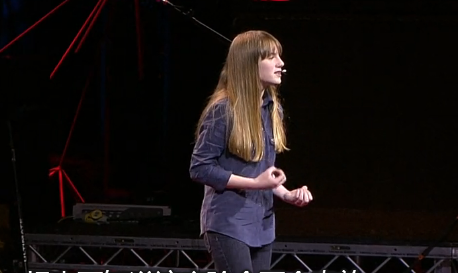The puzzle we came up with was an if-then rule.
我們想出的難題是個”如果-則“規(guī)則。
We asked the bees to learn not just to go to a certain color, but to a certain color flower only when it's in a certain pattern.
我們要求蜜蜂學(xué)會不僅僅是飛向某種特定顏色,而是飛向形成了特定圖案的特定顏色的花朵。
They were only rewarded if they went to the yellow flowers if the yellow flowers were surrounded by the blue, or if the blue flowers were surrounded by the yellow.
只有當(dāng)黃色花朵被藍色花朵包圍,又或者藍色花朵被黃色花朵包圍時,他們飛向黃色花朵才能獲得獎賞。
Now there's a number of different rules the bees can learn to solve this puzzle. The interesting question is, which?
現(xiàn)在蜜蜂可以學(xué)來解決問題的規(guī)律有好幾條。有趣的問題是,哪一條?
What was really exciting about this project was we, and Beau, had no idea whether it would work.
這個實驗最激動人心的地方在于,我們,還有Beau,根本不知道這實驗會不會奏效。
It was completely new, and no one had done it before, including adults.
這是個全新的實驗,過去從沒人做過,包括大人們。
Including the teachers, and that was really hard for the teachers.
也包括老師們,對于老師們來說那真是太難了。

It's easy for a scientist to go in and not have a clue what he's doing,
對于科學(xué)家來說一般進入實驗室后就毫無頭緒,
because that's what we do in the lab, but for a teacher not to know what's going to happen at the end of the day --
因為我們在實驗室就是這么干的,但是對于老師來說,到一天結(jié)束不知將要發(fā)生什么——
so much of the credit goes to Dave Strudwick, who was the collaborator on this project.
于是我們把任務(wù)交給了Dave Strudwick,也就是這個計劃的合作者。
Okay? So I'm not going to go through the whole details of the study because actually you can read about it, but the next step is observation.
好接著我將講述關(guān)于這個研究更多的細(xì)節(jié),因為實際上你可以讀到它,但是下一步是觀察。
So here are some of the students doing the observations. They're recording the data of where the bees fly.
這里是一些學(xué)生們觀察時的視頻。他們正在記錄蜜蜂往哪飛的數(shù)據(jù)。
So what we're going to do 5C. Is she still going up here?
所以我們要做的是——5C。她還在往上飛嗎?
Yeah. So you keep track of each. Henry, can you help me here?
是啊。那你們記錄每一只的路線。Henry,你能給我?guī)拖率謫幔?/div>
"Can you help me, Henry?" What good scientist says that, right?
”你能給我?guī)拖率謫幔琀enry?"牛逼的科學(xué)家就是這么說的,對嗎?
There's two up there. And three in here.
那兒有兩只。這兒有三只。
Right? So we've got our observations. We've got our data. They do the simple mathematics, averaging, etc., etc. And now we want to share.
看到了?所以我們得到了我們的觀察結(jié)果。我們得到了我們的數(shù)據(jù)。他們做了簡單的數(shù)學(xué)運算,平均,等等。然后我們想和大家分享結(jié)果。
That's the next step. So we're going to write this up and try to submit this for publication. Right?
這就是下一步。 于是我們要把這些寫下來并且投稿發(fā)表。對嗎?
So we have to write it up. So we go, of course, to the pub. All right? The one on the left is mine, okay?
所以我們把它寫了下來。所以我們?nèi)チ耍?dāng)然啦,去了夜店。左邊的那個杯子是我喝的,看到了?
Now, I tell them, a paper has four different sections: an introduction, a methods, a results, a discussion.
現(xiàn)在,我告訴他們,一份報告由四部分組成:引言,方法,結(jié)論,討論。
The introduction says, what's the question and why? Methods, what did you do?
引言就是,問題是什么以及為什么?方法就是,你們做了什么?
Results, what was the observation? And the discussion is, who cares? Right? That's a science paper, basically.
結(jié)論就是,觀察結(jié)果是什么?討論就是,誰關(guān)心它?對嗎?基本上,這就是一份科學(xué)報告。











